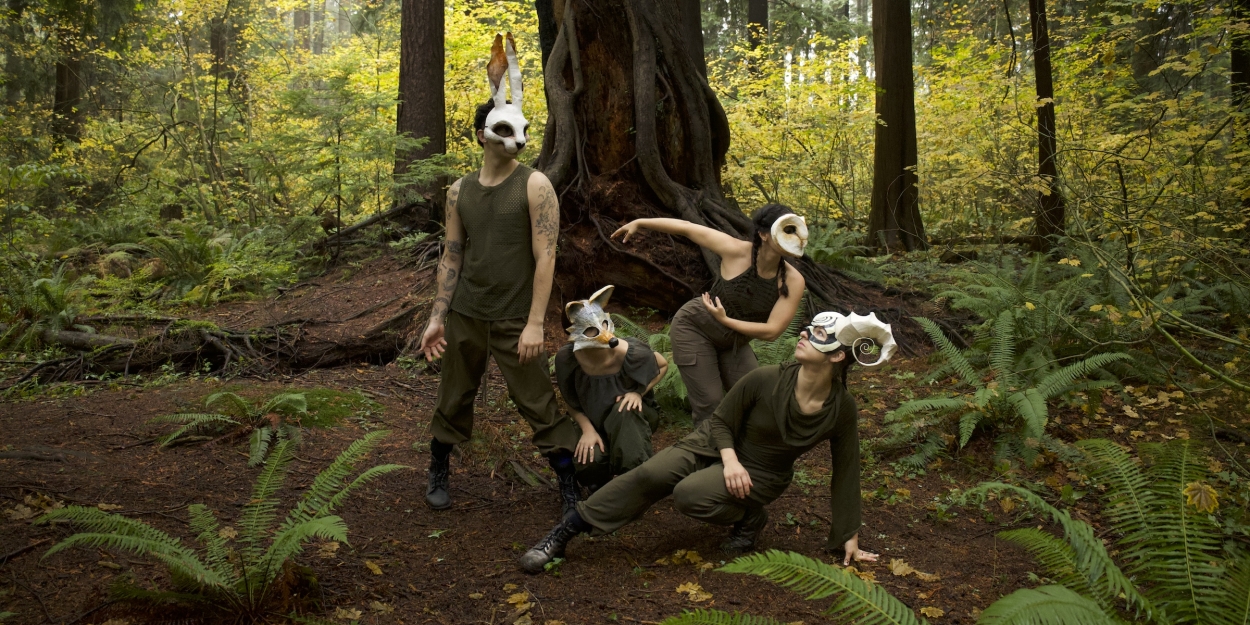Review: UNCLEARING at Harbourfront Centre
Double bill of self-discovery presents many possible interpretations

In UNCLEARING, a new dance double bill from The Chimera Dance Project at Harbourfront Centre Theatre, two works try to uncover the true self, peering behind the masks or fears that stop us from being who we really are. Examining these themes through dance is a very personal matter, and both halves of UNCLEARING, while polished in performance, are snapshots from inside that personal process. As the name suggests, UNCLEARING can be somewhat opaque in its messaging to the audience, but it doesn’t stop it from being a stimulating evening.
Part one of UNCLEARING, AGRIMONY begins while the audience is still entering, seamlessly transitioning the space into performance. To introduce AGRIMONY, co-creator and choreographer Sophie Dow writes, “We honour the small yellow flower agrimony – in plant medicine: a catalyst for honesty, dissolving the masks upon masks society forces us to craft; unveiling a truest self.” These masks are represented in beautifully crafted animal masks: an owl, a coyote, a ram, and a hare, portrayed by dancers Amanda Testini, Tavia Christina, Mohammed Rashead, and Dow.
As the audience settles, we’re encouraged to feel three separate parts of ourselves and of the world: feet on the ground, head to the sky, heart beating in the middle. The owl pulls on a long, thin rope, settling centre stage. Joined by the coyote, the owl begins to knot the rope, pausing and listening to it between knots to uncover its secrets. The rope’s clear symbolism of connection seems to indicate that it’s going to be a large part of the interaction between the dancers, but it’s actually used sparingly during the show.
Instead, AGRIMONY’s highlight is its musical setting, which takes us through an album of co-creator Laura Reznek’s music. If the show had solely been a concert, it would still have been a thoroughly enjoyable 45 minutes. Reznek’s smoky-voiced indie folk, self-accompanied on piano and electric violin, and accompanied by Jonah Ocean on cello and guitar, is appealingly poignant and melancholy. Reznek croons lines like, “Live to be important when you’re gone,” or “My friends keep making noise to keep them busy/Too busy to hear anything at all.” She invites us to embrace the “curious and strange.”
Meanwhile, the predator and prey animals deal with the struggles of insatiable need and addiction over text intoned by a disembodied voice. Each has a different level of discomfort with the mask, from the owl’s relative coolness to the ram’s deep anguish that causes her to collapse on the floor. Eventually, they become more able to connect, participating in graceful trust falls as Reznek sings “maybe rely on me.” It can get a little overwhelming trying to match the content of the lyrics to the movements in the dance to the visuals of the design; the mixture, however, is adept at producing a contemplative mood.
Part two of UNCLEARING is, according to choreographer Malgorzata Nowacka-May, about the fear of giving oneself over to the creative impulse and creating with the power and abandon of a superhero. Nowacka-May’s work starts in an entertainingly familiar space; a group of artists (Tavia Christina, Christian Lavigne, Louis Laberge-Côte, Amy Hampton, Sebastian Hirtenstein, Ryan Kostyniuk, Dana Macdonald, and Mio Sakamoto) drift in to what appears to be a dance class, and a short satire of performative “creation” begins. A couple of dancers stare disdainfully into the audience, intoning, “I see you.” Others suddenly primal scream, remove their boots and sunglasses, or draw attention to their grace and beauty by suddenly adopty dazzling charm, only to drop the face a moment later.
When one dancer suddenly wanders into a magical spotlight, however, the transformation becomes real; we hear the electric crackle of inspiration (from composer Eric Cadesky), and the dancer’s inner nature is revealed. The electricity transfers from dancer to dancer in a kind of ritual baptism, as each is gradually brought “into the light” by a fellow performer. Shedding their white clothing for sleeker, more tightly-fitting black ensembles, they move in tandem with the lightning. The crackling sound effects are interrupted by stretches of an intense remix of a Russian folk song called Zoriuszka (“Evening Twilight”), which retains the driving beat, but lends a richer, earthier timbre to the edgy electricity around it.
Nowacka-May says that it’s difficult to put the themes and progression of her piece into words, and that’s true on the viewer’s side as well. After the lightning-like clarity of the striking change from the “masked” beginning to the “unmasked” aftermath, there are many potential themes one could read into the dance: from the personal to the political, from the fear of one’s art being “too much” to the dangers of following the crowd, from gendered power relationships to internal conflict represented by multiple external players. This means that the piece is rich in interpretation, but might leave audiences unsure about its goals.
I also found myself looking for the work to ascend to another stage or level in the last fifteen minutes; each of the eight dancers gets at least one solo or duet, which admirably highlights the entire company’s talent. Once the cast has all been transformed, though, I wondered, where do we go from here? What is the result of this communal self-discovery, and is it a lasting state, or as fleeting as the burst of electricity that inspired it?
While I wasn’t clear on every moment of UNCLEARING, it was intriguing enough that I didn’t mind.
Photo of the cast of AGRIMONY by Vitantonio Spinelli
Reader Reviews
Videos

